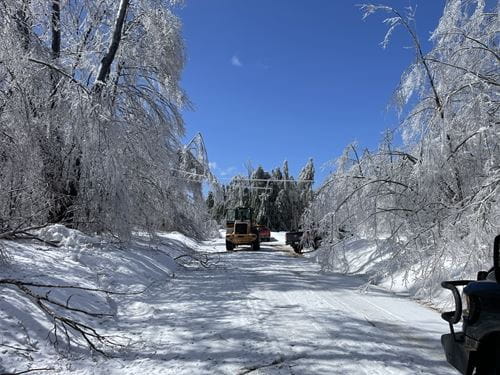The web Browser you are currently using is unsupported, and some features of this site may not work as intended. Please update to a modern browser such as Chrome, Firefox or Edge to experience all features Michigan.gov has to offer.
MPSCS answers the call to assist Michiganders during recent severe weather
April 30, 2025
The storms that hit Michigan this spring serve as important reminders about the vital importance that the Michigan Department of Technology, Management & Budget’s (DTMB’s) tools and people serve in the state’s emergency communications ecosystem.
The Office of Michigan’s Public Safety Communications System (MPSCS) is housed within DTMB and partners with local, state, federal, tribal, and private first responders in all 83 counties throughout the state to support emergency communications and public safety efforts in Michigan. While MPSCS is not widely known by the general public, it handles the second largest trunked communication system in the world, including over 350 radio towers and more than 151,000 radios. Geographically, it covers the entire state, from the northern shores of Lake Superior to the state’s southern borders with Ohio and Indiana. The office oversees daily management of statewide radio system and long-term strategic communications upgrades.
In early April, MPSCS was involved in multiple weather-related events unfolding simultaneously across the state. While a devastating ice storm wreaked havoc in northern Michigan, tornadoes and severe thunderstorms were sweeping through southern portions of the state. These simultaneous events served as a powerful reminder of the need for resilient, coordinated emergency communication systems statewide.

The emergency communications ecosystem consists of several key components.
- Technologies that enable citizens to contact public safety, such as 911 systems.
- Communication systems, like land mobile radio, that connect public safety personnel. In Michigan, this is known as MPSCS, or the state radio system.
- Public alerting systems, such as tornado sirens, emergency broadcasts, and even social media, which allow public safety agencies to communicate with the public during emergencies.
- Broadband and wireless carrier networks, which support both public safety agencies and the public, providing not only voice services, but critical situational awareness through mobile applications.
To support these technologies, effective governance is vital to ensuring consistent, secure, and collaborative use of the ecosystem’s components across each lane of information sharing.
At the start of April, public safety personnel across Michigan were actively using all aspects of the emergency communications ecosystem to prepare for and respond to severe weather affecting the state. During this time, MPSCS served as the backbone of public safety communications across the state. Amid widespread power outages and disruptions to essential services, MPSCS remained fully operational. As noted in the following April 3 post on MPSCS's LinkedIn:
We are proud to report that MPSCS maintained 24x7 emergency communications for first responders across the state of Michigan throughout this crisis. The system performed as it had been designed to do more than 30 years ago. Which was provide public safety the capability to have seamless interoperability between all users, anywhere in the state.

MPSCS is more than just technology—it begins with people and is strengthened by relationships. Our partners at the Michigan Department of Natural Resources, Michigan State Police, Department of Transportation, Michigan National Guard, and county agencies worked together to keep critical emergency communications infrastructure running when most other systems failed.
Teams from various agencies united around a common mission, keeping MPSCS radio sites accessible, fueled, and operational for first responders across northern Michigan. We’re grateful that every team recognized the risk of losing all communication in the impacted areas. Their dedication ensured that radio communications, the lifeline of emergency responses, remained active when it was needed most.
Recent weather events, along with past local, multijurisdictional, and statewide emergencies like dam failures, plane and automobile crashes, and mass casualty events, continue to highlight the need for resilient and modern emergency communications infrastructure. National efforts, such as multistate incident response exercises and global events, including the COVID-19 pandemic, further reinforce this point.
In September 2025, MPSCS will proudly celebrate 30 years of providing reliable, effective emergency communications to federal, state, local, tribal, and private sector first responders. Today, more than 2,600 agencies across Michigan depend on MPSCS, connecting over 151,000 radios to a system that handles an average of 16.7 million calls per month.
MPSCS continues to be a trusted lifeline for public safety professionals. Though its work often happens behind the scenes, the system is recognized globally as a benchmark for public safety communications. Moving forward, MPSCS is remaining vigilant—ensuring continued investment and modernization to meet the growing demands of emergency response across the state and beyond.
To learn more about MPSCS, visit their website at Michigan.gov/MPSCS.
